Maggie’s Back
After an injury derailed her Olympic dreams in 2014, Whitefish’s Maggie Voisin has fought her way back to the top of the slopestyle world rankings with the 2018 Winter Games approaching. She’s wiser, better and hungry to show the world what it missed.
By Myers Reece | Photography by Greg Lindstrom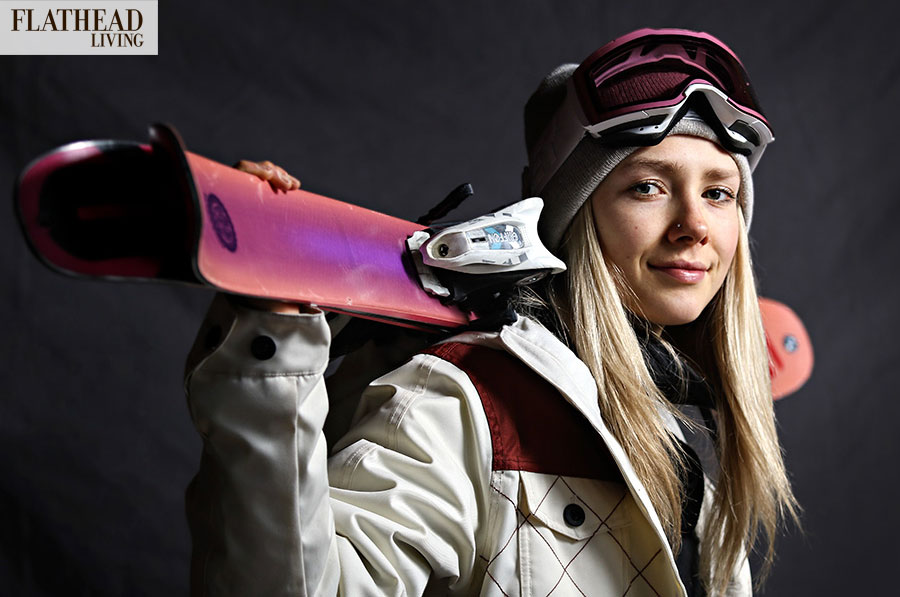
Four years ago, Maggie Voisin became the youngest American in 40 years to make the Winter Games. She was barely 15 years old, a slopestyle skiing prodigy, and she headed to Sochi, Russia as a favorite to medal. Days before competition, she crashed on a rail feature during practice and fractured her fibula, along with her Olympic dreams.
“I told myself that day, ‘I’m going to do whatever it takes to get back to the Olympics,” Voisin said.
Voisin worked diligently to get back into shape for the next competitive season. In her first event, at the Dew Tour Mountain Championships in Colorado, she landed awkwardly after a jump and tore her ACL. The injury left her unable to walk or bend her knee for six weeks. Altogether, she rehabbed for nine months, the longest she had spent off skis since her parents, Kristin and Michael “Truby” Voisin, first plopped her on a pair when she was 2 years old. Her leg muscles, which had carried her to the top of skiing’s hierarchy, atrophied and became unserviceable.
“I had to relearn how to walk,” she said.
There are any number of ways to measure the distance between then and now, between 15 years old and 19, in all its manifestations of physical and mental growth. In purely skiing terms, for Voisin, it’s calculated in degrees of superlatives. In 2014, she was one of the best slopestyle skiers in the world, and now she’s better. So the math is simple, and the desired outcome is easy to see, because it has an unmistakable golden glow and would look stylish around her neck.
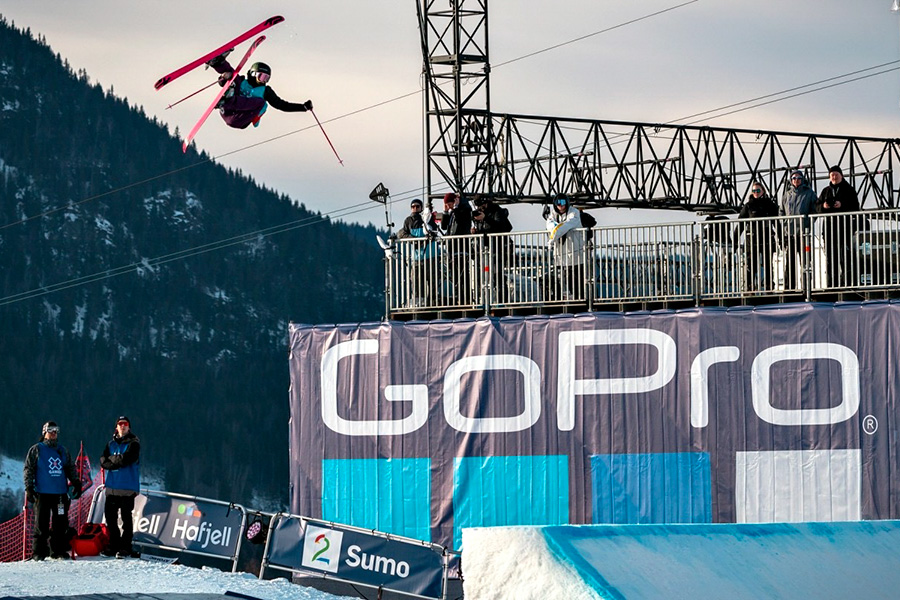
Yet, Voisin approaches the equation from a different angle, arriving at answers that belie her age. Sure, as with any highly competitive athlete, winning a medal on the biggest stage, the Winter Olympics, is the ultimate goal. But she’s been through too much to view her journey through a narrow lens of winning and losing.
There were the back-to-back devastating injuries, the private moments of profound disappointment and distress, the pain in its many forms, the rehab, the months of reflection away from the sport she cherishes, the opportunities to build perspective and mature in ways not many teenagers can understand. That’s a heavy load on the shoulders of a girl who moved away from her parents in Whitefish at age 14 to live and train in Park City, Utah, where the U.S. Ski and Snowboard Association (USSA) is headquartered, and who then carried the additional weight of soaring expectations repeatedly cut down by bad luck.
But every roadblock presented an occasion to learn and contributed to the introspective young woman she has become today, and for that she’s grateful, not resentful or regretful.
“I got to take a step back from skiing and be a normal teenager,” she says. “I learned a lot about myself. I wouldn’t change any of those lows. It’s from the low points that you really grow. I’m not going to say that I was always cheerful. With any injury, it’s easy to get down on yourself. But in those low points you can always find something positive.”
“I get to travel the world with my best friends and do what I love,” she adds. “I wouldn’t trade it for the world.”
Voisin said this in early November, surrounded by family in Coffee Traders in Whitefish, her hometown where she seamlessly strikes a balance between celebrity and laid-back ski girl. She came to the interview directly from the airport and repeatedly apologized for being jet-lagged, though the sorries were unnecessary. In fact, she spoke thoughtfully and articulately, her voice bubbling with emergent self-discovery, as she showed off a precociously astute ability to honestly dissect her triumphs and tribulations. She lived up to a moniker she hears a lot: “old soul.”
Voisin, who turned 19 on Dec. 14, had just returned from a whirlwind two-day stay in New York City. On the first day, she served as a public ambassador for the United States Olympic Committee, conducting media interviews alongside fellow winter athletes, including a television appearance with Matt Lauer on The Today Show. The second day was dedicated to promoting the USSA, during which Voisin networked with high-profile donors who provide vital funding for the national organization. She had traveled to the Big Apple straight from Europe, where she spent the previous three weeks training in Switzerland and Austria with other USSA team members.
Voisin is accustomed to skipping across time zones and oceans, setting up temporary homes in ski communities around the globe while she either trains or competes. She spends much of her year in Park City, working with the USSA, the umbrella organization for the national ski and snowboard teams. While Park City is her home base, Whitefish remains her home, if not in residence then in heart. She tries to return as frequently as possible, including spending her summers here.
“She still has a bedroom here,” her mother, Kristin, says. “I love when she comes home.”
Voisin chimes in, “I haven’t been kicked out.”
Voisin is one of four women on the USSA pro slopestyle team, and they are the frontrunners to make what is expected to be three, perhaps four open slopestyle spots on the U.S. Freeskiing Team for the Winter Games, which are held in PyeongChang, South Korea on Feb. 9-25, 2018. Any Americans who perform well enough during a series of Olympic-qualifying events in December and January can make the Olympic squad, but the pro team members are the highest-ranked and most frequent medal earners at major competitions. They’re the pros for a reason.
Slopestyle is one of two disciplines, along with halfpipe, under the category of “freeskiing,” a newer subcategory of “freestyle,” which includes moguls and aerials. Kalispell-born Tanner Hall was one of freeskiing’s pioneers, while Shaun White is the biggest name on the snowboarding side. A third competitive class, “alpine,” features traditional downhill and slalom races made famous by American skiers such as Whitefish’s own Tommy Moe and, more recently, Lindsey Vonn. In slopestyle, skiers and snowboarders navigate a course containing jumps and features such as boxes and rails, performing aerial tricks and sliding maneuvers. It became an Olympic sport in 2014.

Voisin first began skiing on Big Mountain as a toddler. At age 5, she started riding dirtbikes with her twin brother, Tucker, and earned the nickname “Crash,” displaying a fearlessness that also characterized her skiing. Meanwhile, she was honing her agility, balance and acrobatics at the local figure skating club. She ably put that combination of boldness and elegance to use when she joined Whitefish Mountain Resort’s freestyle team at age 9.
Chris “Hatch” Haslock, a freestyle skiing trailblazer and nationally recognized coach, came across Voisin at the 2011 USASA national championships at Colorado’s Copper Mountain. At 12 years old, she was dominating her peers and, Haslock said later, “could have been winning the pro category.” Haslock invited Voisin that summer to Park City, where his Axis Freeride organization trained, which set in motion Voisin’s move two years later as an eighth-grader to train and live with a homestay family.
In Park City, Voisin split her time between intensive training and schoolwork, conducted through a combination of resources that included online, homeschooling and USSA educational services. She also briefly attended Whitefish High School. At 16, she moved into a Park City condo with friends, although she continued to spend much of her time on the road traveling to camps and competitions. She learned to cook and perform the usual domestic duties of self-sufficiency that most others learn far later, and earned her high school degree last spring.
The performance that put Voisin on slopestyle’s global radar came in 2013 at the Association of Freeskiing Professionals’ world championship in Whistler, B.C., where she finished in first place and was the only woman competitor to successfully execute a switch 900. She was named the 2013 ESPN Rookie of the Year. Since then, she has padded her resume with a sizeable list of top-three finishes at major competitions, including in 2014 becoming the youngest skier, a record since broken, to medal at the X Games.
In February, at a U.S. Grand Prix event in Mammoth, California, she competed against the planet’s best slopestyle skiers in one of the sport’s definitive events and walked away with her first-ever World Cup victory. Mammoth was the first Olympic-qualifying event of the season, meaning Voisin enters the final four qualifiers in December and January with a head start, essentially only needing one more podium to secure her trip to South Korea, according to a USSA coach.
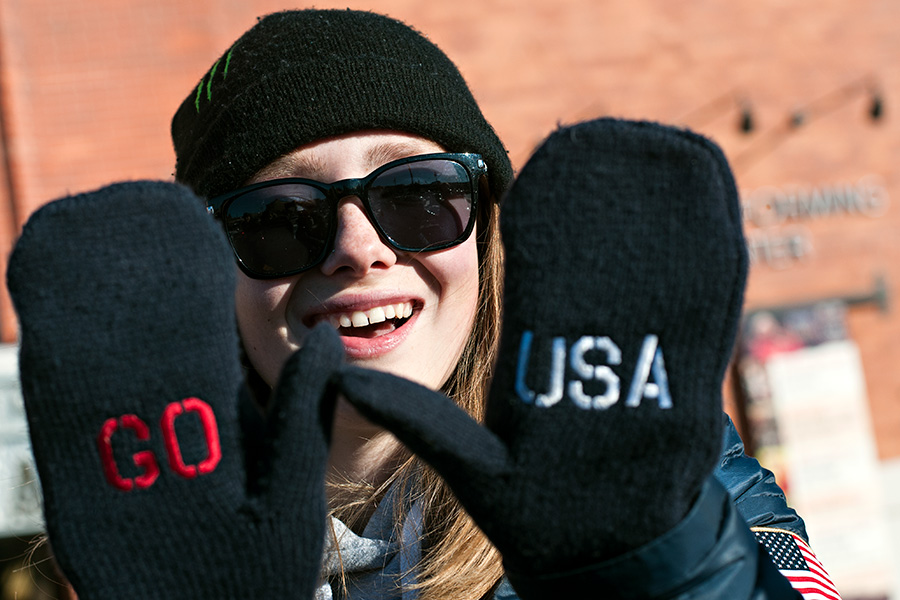
Devin Logan, a 24-year-old member of the pro slopestyle team, has taken Voisin under her wing. Six years her elder, Logan had already learned the ropes of the competitive ski world when she met Voisin four years ago as a fresh-faced 15-year-old adjusting to life outside Montana.
“Getting into the ski scene at 15, doing the media interviews and going to the X Games, it’s a lot to take in at a young age,” Logan says. “I felt that some guidance wouldn’t hurt her. We’d go on the road and I would say, ‘You know, you can do it this way. Don’t let people persuade you to go a different route. Do what’s best for you.’”
“In the ski world, you have to grow up pretty fast,” she adds. “I see her as my little sister. I just want the best for her.”
Voisin is thankful for Logan’s guidance and says the two skiers “are best of friends.” Both of them note that staying in European-style small rooms with double beds tight up against each other offers ample opportunities to bond. In October, they trained for a week in Neustift, Austria, where their friendship first started forming four years ago.
“I don’t know what it would be like without her,” Voisin says. “She’s genuine. I look up to her so much in that way.”
The maturity that is evident in Voisin’s insightful self-reflection isn’t lost on Logan.
“We like to call her Baby Mags, but she’s grown up super fast,” Logan says. “It’s been cool to watch that transformation.”
Yet, the product of that growth is simply a wiser, more layered Maggie, not a new Maggie.
“She hasn’t let all the success get to her,” Logan says. “She’s still a down-to-earth girl from Montana, and she’s a really good person and fun to be around. That’s the best part.”
Voisin has developed as an athlete, too. Skiing came so naturally to her that she didn’t pause to consider the finer points when she was younger, such as diet and body maintenance.
“When I was 14,” she says, “I would just go, ‘Hey, I’m hungry. I’m going to eat whatever.’”
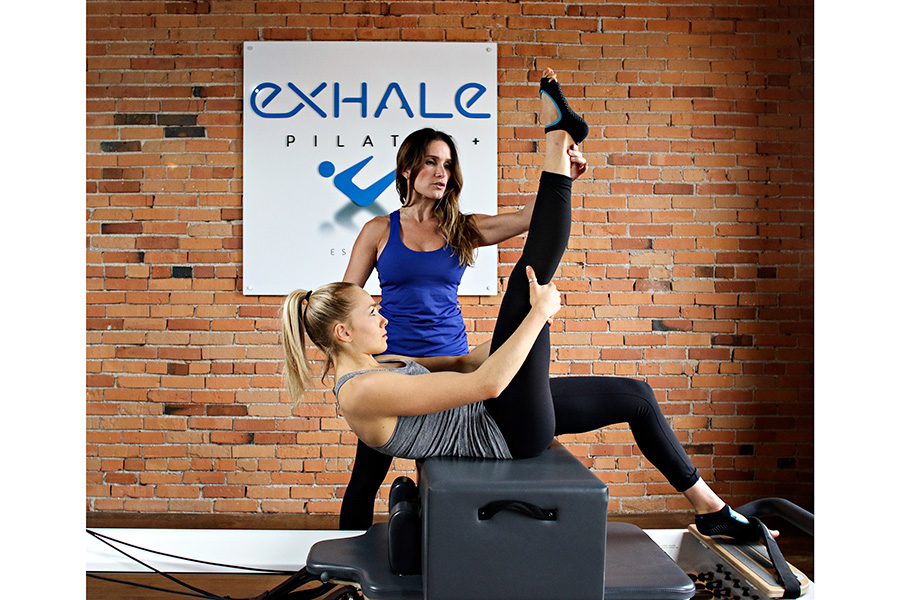
In a way, she believes that enduring injuries at such a young age equipped her with tools that will help ensure a lengthier career: “I realized I’m not made of rubber like I thought I was.” She lifts weights, does Pilates and studies psychology, ruminating on her “high-risk, high-reward” sport being “90 percent mental,” and really believing it.
As of mid-November, Voisin was ranked third in the world in the AFP women’s slopestyle rankings, and Logan was seventh. The top-ranked skier, Kelly Sildaru, a 15-year-old phenom from Estonia, will not participate in the Winter Games due to a knee injury, further opening up the field. While Sildaru is often called the best women’s skier in the sport, U.S. Freeskiing Team coach DJ Montigny puts Voisin right up there with the Estonian, saying one small mishap here and there has often been the difference between the two.
“Personally, even with Kelly in the field, I’ve always thought Maggie has been able to compete with her on any given day,” Montigny says.
Montigny says Voisin’s performances over the last couple years should be viewed in the context of recovery. Coming back from injuries, she has been progressively implementing new tricks and technical aspects, with the goal of putting them all together heading into the Olympics. In other words, we haven’t seen Voisin at full potential yet. Still, she’s been one of the best skiers in the world, and one of the only who can consistently land complicated aerial maneuvers like the rodeo 900.
Montigny called Voisin’s injury in Sochi “one of the harder coaching moments I’ve ever had,” recalling how heartbreaking it was to see her in tears in the hospital, but he’s pleased with how she bounced back and how strong she looks now.
“Everything is starting to click for her,” he says. “She’s very confident. She’s having fun and enjoying skiing. She’s definitely carrying momentum to be a heavy competitor at the Olympics. She’s ready to go.”
Montigny and Logan both say Voisin has unique skills, with Logan pointing to her friend’s innate intangibles that give her performances an aura of effortlessness.
“Maggie has such a talent at skiing, it’s kind of crazy to see her do things,” Logan says, mentioning that the two skiers push each other through friendly competition. “She gets new tricks on the first try. It’s fun to watch her.”
Searching for the proper words, Logan continues: “She just has air awareness or something. I can’t describe it. It takes me a long time. I crash and fall before I learn a new trick. She just goes, ‘I’m going to go for it.’ And she does it.”
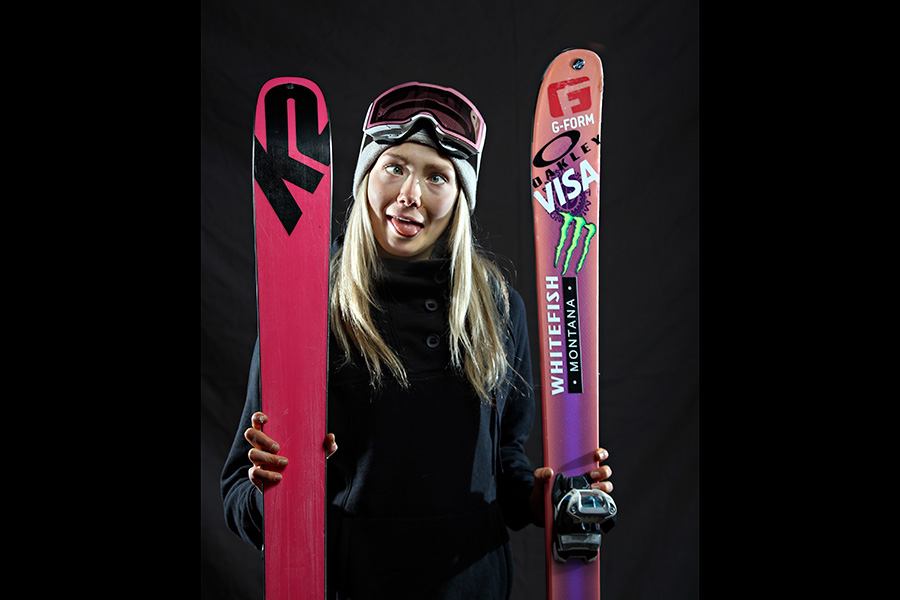
Voisin’s sport has evolved as well. There are far more women slopestyle skiers, and whereas four years ago only a handful would regularly compete for medals, now the field is stacked. Although Voisin acknowledges that she’s “going for the podium like anybody else,” she’s motivated by forces that are at once more genuine and more important, not to mention healthier, than medals alone, an approach that centers her.
“I don’t want to get overwhelmed by everything — just stay focused on myself and what I have to do,” she says of her mindset, breaking it down further: “It’s about having fun, loving it and just skiing like Maggie.”
“I put my whole heart into it. It’s my passion. I do it because I love it and I want other people see that and feed off it.”
That desire to reach other people is part of Voisin’s broader, big-picture goal to be a role model on and off the mountain. She plans to get more involved with causes and charities, and she especially hopes to be an example for young girls. Even when discussing her appearance in a recently released ski film, Good Company’s “Guest List,” she interprets the experience not as a platform to grab the limelight but as an avenue to showcase her sport and specifically the women in it. Maybe a 9-year-old girl with big ski dreams in a small town will see the movie, along with the possibilities it embodies.
“At the end of my career, I could have all these medals,” Voisin says, “but I really want to make sure I left my mark and inspired young skiers. Devin has left a mark on me, and I want to be that for other skiers.”
But Voisin is much closer to the beginning of her career than the end, and Logan knows her friend has immediate unfinished business to tend to, first in securing a trip to South Korea and then in reminding the world what it missed when she was sidelined in 2014.
“She needs a little bit of revenge on the Olympics because of what happened when she was in Sochi,” Logan says. “I think that’s a fire inside her. She’s made a lot of progress.”
After a pause, she adds: “Maggie is definitely someone to keep your eyes out for.”
Read more of our best long-form journalism in Flathead Living. Pick up the winter edition for free on newsstands across the valley, or check it out online at flatheadliving.com.